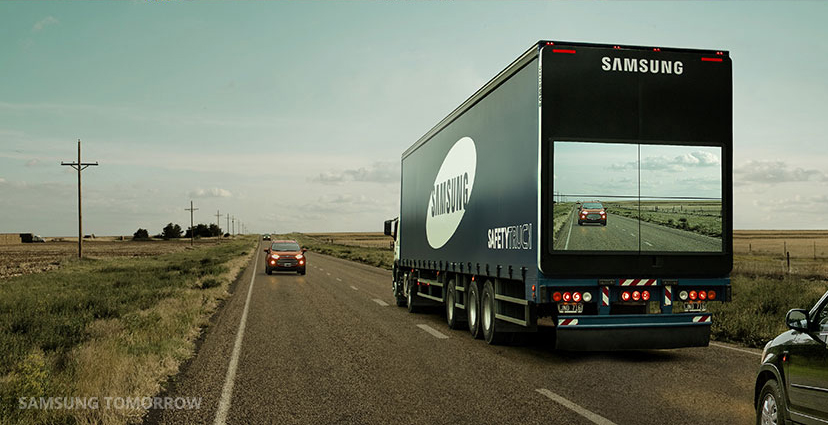Samsung Unveils the See-Through Semi

There may still be some debate about whether or not we can call this the Age of Convenience, but it is certainly becoming more convenient for drivers. Motorists now have access to technology that enables cars to parallel park on their own, reverse with no rear view mirror required, or warn of obstacles in their blind spots. Meanwhile, self-driving cars are quickly becoming a “thing.” Now, Samsung has adapted the same “rearview” window technology into a see-through semi that could help drivers travel in reverse without craning their necks.
Semi’s have a way of slowing down traffic, particularly on those one or two lane highways where the speed limit is high, but a truck’s ability to take those winding curves at 55mph is…not. Every driver has experienced the frustration of wanting to take the leap across the dotted yellow line but without knowing what is waiting around the corner, it is hard to pull out in front. This is where the Samsung Safety Truck would be a definitive solution.
The concept was initially attempted by Art Lebedev with their Transparentius Semi. A camera is attached to the front of the truck and connected to a series of flat screens on the back. Drivers stuck behind the semi are able to see everything that is happening ahead of the truck, and can then make an informed decision about when to try and pass.
It seems like a fairly straightforward idea, but there are some mitigating logistical factors to consider. For one, coordinating four flat screens and installing them on the back of a semi is easier said than done. For another, the inexpensive camera does not make up for the significant investment of the screens. Any transport company attempting to make the improvements to their vehicles would be undertaking a significant financial burden. Though the prototype truck is no longer operational, Samsung has made great strides in solving technical challenges such as solar glare and proving that the concept works.
At the pace things are developing, it may not be long before the idea of a see-through semi becomes entirely obsolete. While Google continues to perfect the idea of a car that can drive on its own, companies like Ford are demonstrating the benefits of Vehicle-to-Vehicle communication or V2V. Using wireless sensors, it is increasingly likely that cars will be sharing information, avoiding obstacles and driving us around without any need for a driver at all.
